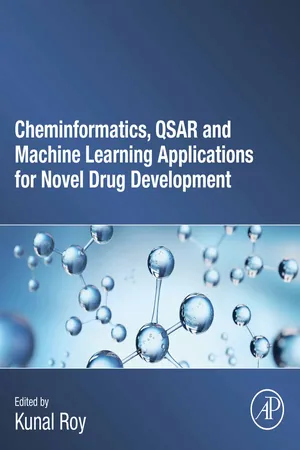
Cheminformatics, QSAR and Machine Learning Applications for Novel Drug Development
- 768 pages
- English
- ePUB (mobile friendly)
- Available on iOS & Android
Cheminformatics, QSAR and Machine Learning Applications for Novel Drug Development
About This Book
Cheminformatics, QSAR and Machine Learning Applications for Novel Drug Development aims at showcasing different structure-based, ligand-based, and machine learning tools currently used in drug design. It also highlights special topics of computational drug design together with the available tools and databases. The integrated presentation of chemometrics, cheminformatics, and machine learning methods under is one of the strengths of the book.The first part of the content is devoted to establishing the foundations of the area. Here recent trends in computational modeling of drugs are presented. Other topics present in this part include QSAR in medicinal chemistry, structure-based methods, chemoinformatics and chemometric approaches, and machine learning methods in drug design. The second part focuses on methods and case studies including molecular descriptors, molecular similarity, structure-based based screening, homology modeling in protein structure predictions, molecular docking, stability of drug receptor interactions, deep learning and support vector machine in drug design. The third part of the book is dedicated to special topics, including dedicated chapters on topics ranging from de design of green pharmaceuticals to computational toxicology. The final part is dedicated to present the available tools and databases, including QSAR databases, free tools and databases in ligand and structure-based drug design, and machine learning resources for drug design. The final chapters discuss different web servers used for identification of various drug candidates.
- Presents chemometrics, cheminformatics and machine learning methods under a single reference
- Showcases the different structure-based, ligand-based and machine learning tools currently used in drug design
- Highlights special topics of computational drug design and available tools and databases
Frequently asked questions
Information
Table of contents
- Cover image
- Title page
- Table of Contents
- Copyright
- Dedication
- Contributors
- Preface
- Section 1: Introduction
- Section 2: Methods and case studies
- Section 3: Special topics
- Section 4: Tools and databases
- Index